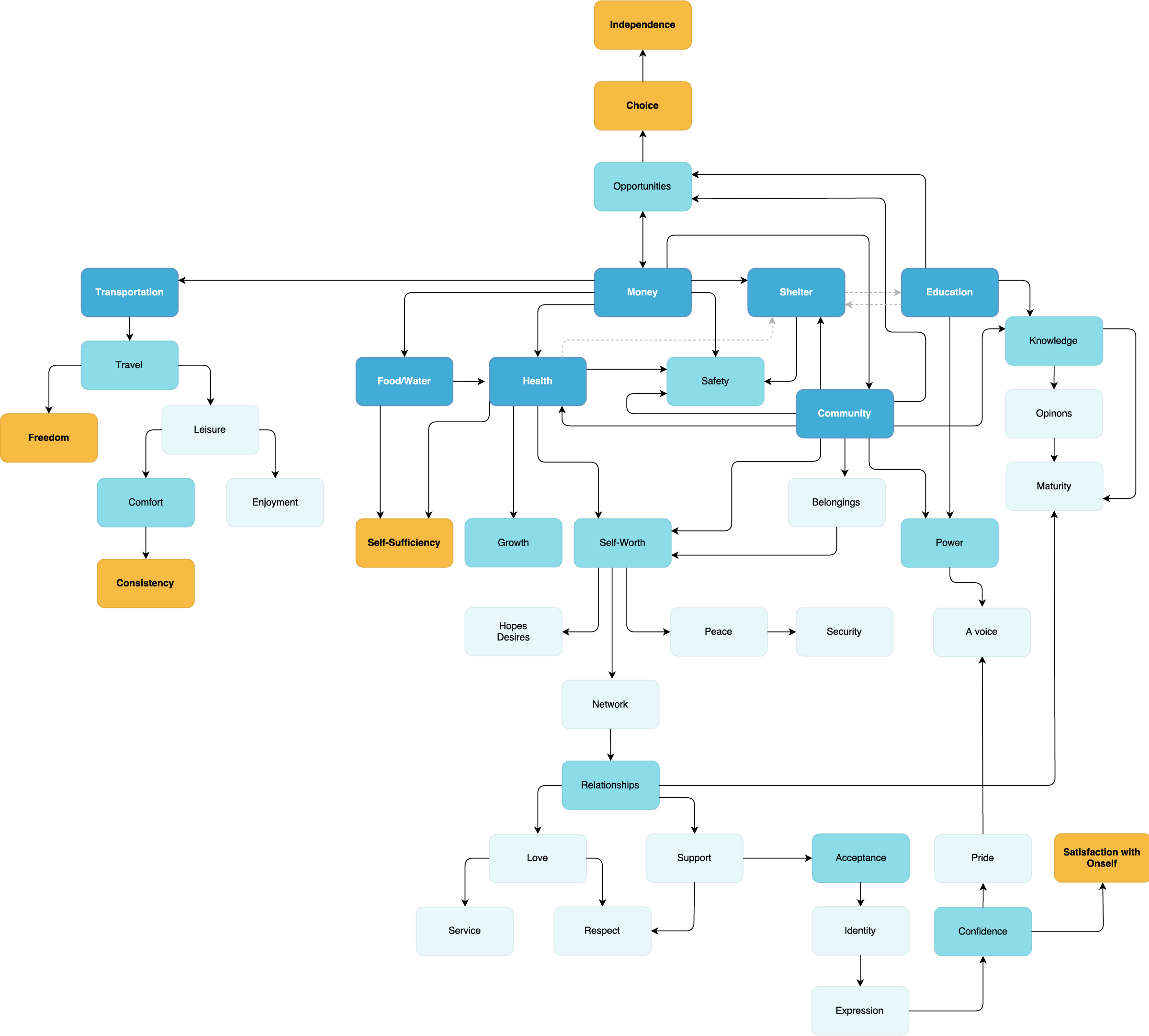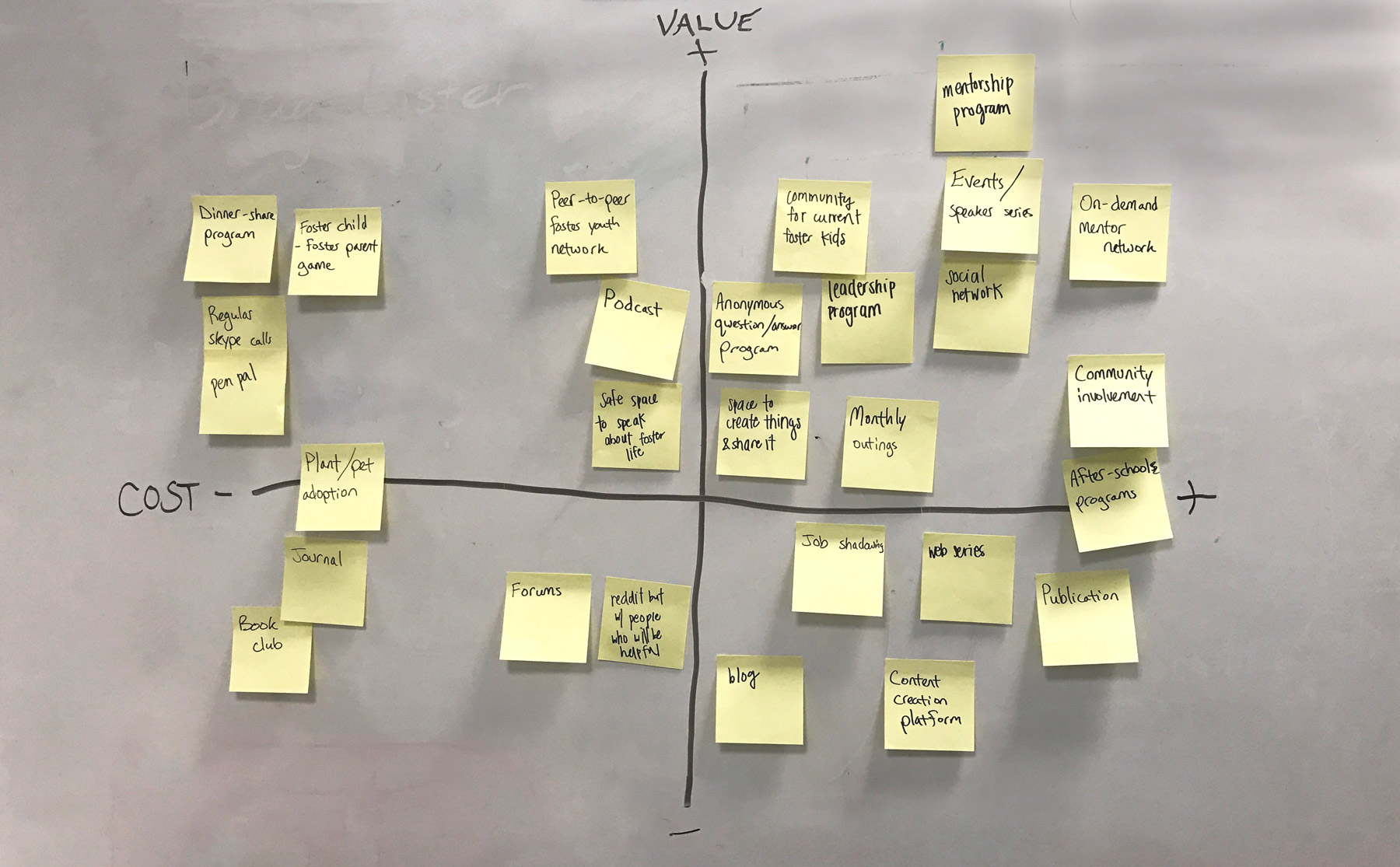Reframe
Investigating the Massachusetts foster care system from a service design perspective
goal
Develop a service design concept to enable autonomy in foster care children. Conduct comprehensive research on the foster care system at large as well individuals' experiences within it. Identify key stakeholders relative to children in foster care. Work through challenges and mitigate risks faced by children in foster care.
skills
- Systems modeling
- Stakeholder mapping
- Experience mapping
- User stories
- User research
- Storyboarding
- Service blueprinting
date
Spring 2017
teammate
Strategy
Reframe project brief: Use service design to enable a sense of autonomy in someone who is alone.
Exactly what the service would be and who it would help were left entirely open. Seeing this as an opportunity to leverage design for social good, Christine and I chose children in the foster care system as our target demographic. With that decided, our next step was to define autonomy as it applies to children.
We started defining autonomy by brainstorming actions, items, and feelings we associated with freedom of choice. We then began grouping these words, ultimately creating a systems diagram that illustrates the relationships and feedback loops between the various components of autonomous living. Color was used to introduce hierarchy, with gold nodes representing goal states and dark blue nodes identifying key requisites.
Discovery
Initial framing around autonomy highlighted major gaps in our knowledge of developmental psychology and the foster care system at large. Keeping this in mind, we drafted a research plan with specific goals, covering big-picture information about foster care and the personal experiences of those who work or live within it.
We then created a stakeholder map illustrating key figures in the life of a child in or at risk of entering foster care. People placed closest to the center are those with the most influence over the child's autonomy, based on the factors identified in the Strategy phase. This mapping was derived from initial research and led to a focus on the relationship between foster child and social worker.
Having identified the major stakeholders in a child's foster care experience, we ran through some basic task analyses to empathize with challenges faced by children, social workers, and foster parents.
User Interviews
For a number of obvious reasons, we chose not to pursue interviews with children currently undergoing foster home placement. Instead, we sought out stories from past foster youth such as Noel Anaya.
We did, however, conduct interviews with a variety of professionals and foster parents including Emily Mann, an accomplished Senior Research Associate with a Ph.D. in Social Welfare, and Elise Dallimore, an Associate Professor specializing in organizational development.
These personal accounts and expert perspectives were hugely influential in our understanding of the foster care system, the struggles of those within it, and the gravity of the situation as a whole. Perhaps the most crucial insight was that a positive feedback loop can exist for foster care youth who become traumatized by their time in the system, develop emotional or psychological issues, have trouble finding permanent placement due to that fact, then have their temperment erode further as a result of repeated relocation.
Every interview subject agreed: stability is essential for a child to have a fair shot at success.
Experience Mapping
As our understanding of the foster care experience solidified, we combined qualitative and quantitative research findings into an experience map. The diagram includes important touchpoints and stakeholders throughout a child's foster care experience, charting the emotional impacts of each. Diverging paths at the moment of relocation are accompanied by their statistical likelihood, illustrating in broad strokes some of the starkly different outcomes possible.
This chart is no doubt overly clinical representation given the emotional turmoil and profound nuances present in almost all foster care cases. However, it clearly shows the value of minimizing relocations while working towards reunification or long-term adoption. It also highlights the huge statistical disadvantage faced by foster youth who age out of the system.
Service Blueprint
Our research, interviews, and user journey made it clear that for children, true autonomy was the result of stability. Minor stability could possibly come in the form of social support or daily personal routines. Major stability, of course, would come in the form of reunification or a happy adoption. Christine and I set out to conceptualize a service that could offer both minor stability and a path towards major stability.
We began by brainstorming any and all services imaginable. Next, we plotted these services on a grid of cost vs. value. Cost is measured by how logistically difficult a service would be to implement. Value is measured by the meaningful impact a service could provide for a child in foster care. An ideal service would reside in the upper-left quadrant, being both low-cost and high-value.
After some consideration, we decided to explore the concept of a board game designed to be played by both foster child and foster parents. Christine and I both knew firsthand that games had the potential to offer a valuable sense of escapism, even if only for an hour or two at a time. Well-designed games also have a knack for sparking genuine social interaction, helping players get to know one another in a surprisingly natural way.
Could game theory be used to design an experience that was both entertaining and therapeutic for children in traumatic situations? Furthermore, could this game deliver insights to key stakeholders, helping parents and social workers better understand the child they care for?
Hero's Journey
To demonstrate the potential of our game concept, we modeled a hero's journey starring a persona named Susie. Based on the monomyth narrative template, the hero's journey describes a hero (or user) who leaves their comfort zone, travels to a new, fantastic world, achieves victory, and returns home a changed person.
Using this model is a quick and easy way to gauge the value and transformative capacity of any service or product. In this case, it illustrates Susie venturing out of isolation, agreeing to play a boardgame, temporarily overcoming her fears and anxieties, daring to open up to those around her, and, by the end of the game, having a slightly more meaningful connection to her foster parents.
Storyboarding
Next, Christine and I further developed our Hero's Journey into a more detailed storyboard. The dual-track storyboard illustrated both the user-facing experience (top row) and the unseen technical functions of the game (bottom row).
By this point, our concept for Reframe had expanded to include Susie's social worker who would be instrumental in ensuring her stability and autonomy. The game would now not only facilitate meaningful interactions between Susie and her foster parents, but also interpret and report player data to Susie's case worker who could monitor her emotional well-being and development.
Service Concept
The final step in our process was to translate our storyboard into a brief service concept video of arbitrary fidelity. Our goal in making the video was to create a succint and compelling description of our final concept without the distractions of amateur actors or fully-realized visual design.



